We came as 11 co-workers and left as a family. In June 2018, our multinational team of Parsons employees came together to build a vital footbridge for the hamlet of Banacito, Panama. It took collaboration and innovation – and we were left changed by the experience. Below, we share our reflections on delivering a better world.
Anne
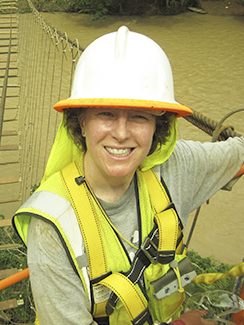
What an experience! Intense, but so rewarding.
Eleven people from Parsons’ team came together, in a hot and humid environment, often in hard rain, with our feet in the mud, looking to achieve the same goal: to build a bridge in 12 days. We faced the same obstacles, carried heavy materials, and pulled many, many cables (Again? That wasn’t the last?), doing all work by hand, using no machinery. We had to find solutions to get everything in place, the right way, with all the appropriate verifications, in a short period of time.
Eleven people took care of each other. We stayed safe, communicating and translating between English and Spanish for everyone’s understanding, and kept to the on-site schedule by working long hours each day and following a new shower order each night—the principal nighttime activity!
Eleven people from different business units worked together. We got to know each other at work on-site and in pyjamas at the camp site, even learning who snored during the night, with a rooster waking everyone up at different hours! We became close and always shared a good team spirit.
I am proud to have been part of that team and to have achieved all we did.
I’m proud of how we worked with the local community. The community was involved and interested in the bridge construction. The local people worked hard and were so helpful, which was really motivating.
On inauguration day, emotion was in the air. We could feel it from everyone.
We all built the bridge together. What an experience.
Bianca
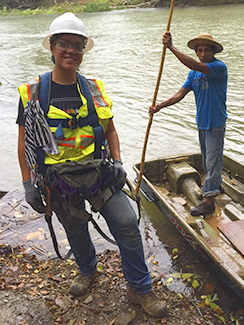
Banacito, Panama—a place that’s filled my heart and mind with lifelong memories. It was a challenging two weeks of long working days in the rain, humidity, and the Panamanian sun, but the bridge is complete, and oh man was it worth it! Our team worked side by side with over 30 community members and celebrated with the bridge’s inauguration on June 16th. I have a story for every hour of the day, but some of the most heartfelt and most challenging moments include having to walk away from the bridge site when the river became impassable, knowing that the community members who stayed behind would have to sleep there for the night, and watching the community members, some more than 70 years old, carry the deck board (all 200-plus pieces) literally on their backs, uphill, to the site. The determination, work ethic, and support of every member of the Banacito community was unreal and humbling. The highlight of the trip was working with Christian, a 10-year-old from the community who hung around for hours during his week off from school waiting for us to give him something to do. The smile on his face when I asked him to pile small pieces of cut wood was priceless.
I am forever thankful to Parsons, Bridges to Prosperity, the Parsons Banacito 2018 team, and the entire Banacito community for the experience of a lifetime.
Brad

I thought I had prepared myself mentally for two weeks of hard work and tough living conditions. I had most of the conditions right in my mind, but the actual work and conditions were still tougher than I had imagined.
What got me through were several very positive experiences that significantly outweighed the challenges:
- A great team. Eleven people from all over Parsons (varying by geography, position, work type, age, and gender) working and living together, discovering strengths, and getting to know each other a little too much, along with the six B2P people providing expertise, direction, and encouragement, as well as pizza and soda.
- The local community. Working with the locals while using very bad Spanish, hand signals, and pointing to solve all kinds of problems.
- The need for the bridge. Times when two of our team members were stuck on the other side of the river and, more importantly, when a handful of teenagers couldn’t get home until after midnight because the river came up without warning really drove home the need for the bridge.
Looking back, it was amazing to show up on Monday morning with a bunch of raw materials and foundations and to leave late Thursday night in the dark, 11 days later, with a 106-meter bridge crossing the river.
The days were long, hot, muddy, and wet. The nights were too short and still too hot. The food was delicious, but I missed a lot of delicacies from home (burgers, ice cream, yogurt, and cold water). Minimal contact with the outside world was peaceful and a blessing, but I missed my family.
Given all of that, I would do it again in a heartbeat.
A couple of closing thoughts for anyone considering a trip like this:
- Prepare yourself mentally for a tough two weeks.
- Roosters don’t care when you went to bed or how hard you worked the previous day. Learn to ignore them.
- A 106-m bridge is a significant structure no matter the location, but in the jungle, it is a lot of tough, demanding work.
- Enjoy the experience, people, culture, and scenery.
- The spiders are bigger in Panama, but there are fewer mosquitos than in Minnesota.
Cameron
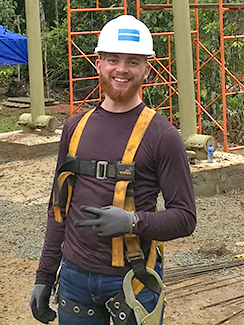
When I left Baltimore, Maryland on June 2, 2018, I was not prepared for the world I was about to step into and the impact it would have on my life. Certainly, I could guess. Two weeks in the jungle of Panama, building a bridge – as a computer engineer. Which, I might add, makes no sense. However, when I returned home, I brought with me an experience and friendships that will forever persist.
As I poured through the bridge documentation and suspender schedules in the weeks before our trip, I could in fact identify that the thing in the picture was a bridge. I had no concept of size, length, effort or the time that it was going to take in order to construct this bridge. I sent an email to Rob Brunner simply stating, “Not the best at bridge construction…. but I’m pretty good a following directions. Also pretty handy at picking up heavy things and moving them to another place so that could be useful.”
And then we arrived at the worksite that Sunday afternoon. My eyes grew as I began to understand the breadth and depth of the task ahead of us. One-hundred and six meters spanning a river that could only be crossed a few men at a time in a canoe. So, we got to work pulling cables, and raising towers. Slowly constructing the longest foot bridge in Panama.
However, something was missing. Why were we here? Did the locals really need this bridge after getting by successfully for so long? This is a cool project, but what difference are we making besides saving 10 minutes in a canoe. And then it happened. The rains came. All day there was storm, thunder, and lightning. We continued to toil and were wet and miserable to meet the deadline for this bridge. As Calvin, Joyce, and I hoisted cables, we looked up, and the river began to flood. A torrent of water swept through in the blink of an eye and we were stranded – on the other side of the river. We had no access to our campsite, our clothes, our food or our teammates. Wet, tired, and miserable, Calvin and I hiked over an hour back into the mountains and into the village of Banacito.
It was absolutely beautiful. The clouds clinged to the trees, and the valley spread out below us. A humble, yet alluring village welcomed us into their homes that evening. The village of Banacito clothed us, fed us, and even treated us to a riveting game of bingo. We ate pancakes and laughed with locals, listened to the children squeal with joy as I gave them nickels to join us in the bingo game. And finally slept soundly in the home of a kid from New Jersey who enjoyed the company of two American boys lost in the jungle. Shortly after midnight, the locals who had been on the other side of the river, with the Parsons crew, finally returned home to their families.
It was then that our mission had become clear. When that river floods, there is no access to medicine, local government or the luxuries of civilization. Even worse, there is no way home for those stuck on the other side. The Banacito bridge constructed by Bridges to Prosperity, Parsons, and the locals of Banacito provides an unobstructed and safe path home to all who travel in that region. No longer will the people of Banacito be repressed by that river and the rains that flood it and the people of Panama are one bridge closer to prosperity.
The building of this bridge also forged a family between all who participated. Now I will always know and never forget how close you become with someone you share a tent with, how much we hate and love safety moments at every meal, policing the crew on a Saturday night, never letting Bianca and Maria let loose with a can of Pringles, how much I love Superman, racing a princess to the showers, laughing at layer two jokes no one else gets, being stranded in the jungle and forgetting then remembering conversations that bonded us forever. So here is to Parsons, Bridges to Prosperity, Banacito, Panama, and friends who will persist for a lifetime.
Dave
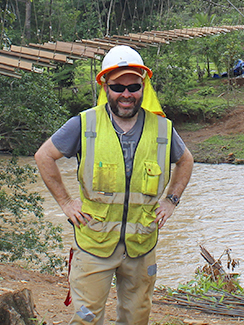
Thinking about this experience, one description comes to mind—life changing—and not just for me, but for our team as well as the local community! The time spent on the phone, writing and reviewing plans, and browsing through videos, photos, maps, and drawings provided but a sliver of what the project would entail. The adventure started near LAX, during a sendoff dinner with my family. I captured a clip of my wife telling a story and laughing hilariously, not knowing this would help carry me through the next two weeks. Being apart and largely out of touch with my wife and children was tremendously difficult. The group formed quick and deep bonds; I will forever remember the warmth and support of the team, like a thick, plush blanket on a cold night.
After lunch a few hours outside of Panama City, the narrow road took us higher and deeper into the jungle. Our sense of isolation deepened with the end of the pavement (and our cell service) and the start of a rough dirt road that stretched across the valleys and carved through the hillsides. Each of our vehicles
gingerly forded a river before arriving at our small campsite. It had a basic latrine and a cold shower that we came to crave after each long, hot day of work. Our meals, cooked over an open fire, were provided by a caring and loving family up the hill in a simple structure that can be best described as a series of interconnecting porches (no walls, doors, or windows, with light from a fire and water from a tank filled from the river). The children melted my heart, especially the cousins, Anna-Gloria, 4; Antonio, 7; and Patricio, 11. Barefoot, in shorts and T-shirts, they gave us high fives and were all smiles, all the time.
I was excited to see the work site for the first time and eager to get to work! The local community members were amazing—friendly, strong, and industrious. Lacking machinery, material handling was a tremendous challenge. We moved what seemed mountains—heavy tower components, thick steel cables, heavy boards, and suspender assemblies, all with temperatures and humidity approaching triple digits as well as constant rain storms.
The width and fury of the river quickly made it clear why the bridge was so desperately needed. Several times, it was impassable by boat, stranding our team members on the far side and preventing local community members from making it home at the end of the day. The team’s excitement was palatable as the two towers were erected, as was our collective disappointment one day when we had to stop early due to a lightning storm. As the cables were hung and set, the bridge started to take form. This advanced as the suspenders were hung and the deck planks installed. As a team, we did our best to settle into a nightly routine of eating, washing up, taking a brief time to relax and talk, and then getting ready for bed, only to be roused from sleep by the rooster at 3:30 AM! Our last day of work, we started at 6:30 AM and worked until 8:30 PM, when we declared the bridge finished! The next day, many of us wept openly as the community members, one after another, spoke about the legacy of the bridge, how it would change their lives, and how they would care for it. While each of us dearly missed our homes and families, this experience was much more than building a bridge; it was about a family of 11 from seven states and three countries who came together and connected with each other in the Parsons spirit while accomplishing something that will forever improve the lives of the local community.
Diane
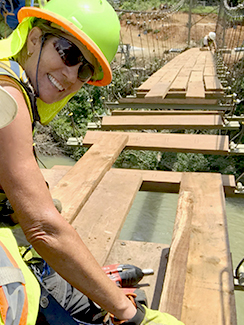
Of all my experiences, this is the hardest to put into words.
I excitedly prepared for the project because I was confident that I understood all aspects of the trip, but:
- The rain never let us dry out, closing roads to supplies and preventing team members from returning to our camp site (overnight). Additionally, the wet work site had numerous safety issues to overcome.
- The sun was not enough to dry us out but was enough to cause heat stress for half of us.
- The work was strenuous, lasting 10 to 12 hours every day, for 12 days without a break!
- Our camp site, set up by the community with pride, was by far the best possible, but the mud made it trying.
- Our meals were very good, but after 12 dinners, 12 lunches, and 12 breakfasts of chicken, rice, and bananas, I dreamed of crunchy vegetables. (Pizza night was a real morale booster.)
- The communication was difficult (but manageable and often humorous).
Each singular challenge could be successfully overcome, but all the aspects together could seem paralyzing. Am I glad I went? Absolutely!
So what built this amazing bridge and friendships?
- Each person giving more than they thought they had.
- Our positive and humorous attitude before, during, and after “work hours.”
- The Parsons family team, the B2P team, and the local community team, together becoming a dream team!
I am still in complete awe of the bridge itself and that we built it. I enjoyed getting to know and working with each Parsons employee—the personality mix was really enjoyable. B2P’s staff is incredible, and the community members’ passion and involvement, without a doubt, made it possible and showed their desire and need for a bridge, which became contagious!
What brought tears:
- Watching a parent carry their child who has muscular dystrophy down a slick muddy path and into a boat twice that week.
- Teenagers sleeping in our work shed because they couldn’t cross the river.
- School children carrying their school uniforms in bags so they wouldn’t get dirty going to school.
- Our boat courier (who ferried heavy planks, wire cable, generators, etc., through strong currents with only a long pole) excitedly pointing at the bridge midway across the river and telling me to take a picture!
- The children and their families celebrating with dancing, food, and speeches.
- The community members passionately saying they will be “forever grateful.”
Dima
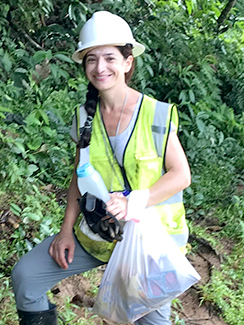
“Do not underestimate a moment of your kindness. It has the power to change lives in ways you may never know.” — Patricia Polacco, Author
It was a great honor for me to be selected to represent Parsons’ MEA unit, to be a part of the team that was going to Panama to join forces with Bridges to Prosperity to build a pedestrian bridge for a community that would change people’s lives in ways we couldn’t know.
The experience, and the challenge, began for me when I boarded my flight in Abu Dhabi airport, knowing that there was no turning back and I would be off to Panama to meet the rest of the Parsons team and build a bridge. I was nervous because I did not know anyone and because it was going to be in the middle of a jungle in a country I knew nothing about except what I’d read, but my excitement and curiosity was too great to allow my doubts to take over the steering wheel.
When I arrived in Panama, it was a relief to meet the team and learn that we had two things in common: we were all part of the Parsons family and we were all there for the same goal—to build a much-needed bridge.
The experience came with two weeks of hard work and challenges. The challenges came in different colors, from weather conditions (being blessed with rain most of the time) to communication with the locals and between team members, camping and sleeping arrangements, waking up in the middle of the night hearing different sounds (from snoring to different insect animal sounds), and waking up very early in the morning thanks to the roosters.
Being off the grid for two weeks was amazing, as it was like detoxing from technology, providing peace of mind as well as an opportunity to connect with the team, learn more about them, and grow closer together, to feel more like a family rather than 11 random Parsons coworkers who were in Panama to build a bridge.
The experience was incredibly humbling and unforgettable, with new friendships and memories made. I am grateful and honored to have been part of the experience.
Edwin
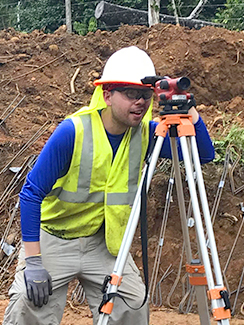
I told myself that 2018 was going to be a good year, an opportunity to do something different. When I saw the post on PWeb to apply for the Bridges to Prosperity Panama build, I knew I had to try. This was the opportunity I was looking for to do something outside of my normal day-to-day lifestyle, and, more importantly, it was a chance to give back.
When I received the email saying that I had been selected to join the Panama team, I was full of excitement. The news really made my day! When I had my first video/phone call with the rest of the team, I could tell everybody was as excited as I was. Fast forward a few weeks, and I find myself in Panama, meeting the team in person—well, part of the team, as this was a two-day process due to different arrival times. The team was diverse, with people from all over the world and from different walks of life. I knew we were going to learn a lot from each other and that this experience was going to be one for the books.
The following day we drove over to the site where we would set up camp. We met with our host, Mariela, and her family, who were very nice and welcoming. They had cleaned up the camp site by removing tall grass and weeds, and they also set up tarps to shield our tents from the rain. I could feel the excitement in the air. Our host and her family were happy to see us, and we were happy to see them. Mariela would always have breakfast, lunch, and dinner ready for us, and everything was always fresh and delicious. This was one of the perks of being here; we didn’t have to cook or clean up after every meal, which was something I was very grateful for, especially after a hard day’s work.
The build was the best part of the trip, even though the conditions were not ideal. I’m talking about the heat, humidity, and, for the most part, the constant rain. Despite the conditions, working alongside the community members and the Bridges to Prosperity team that joined us for the build was amazing. After the ice was broken, we connected on a different level. The language barrier might have been difficult for some at first, but after a few days we were all speaking the same language—the language of making progress.
I’m very happy that I was able to participate in this amazing project. I met a group of strangers who turned out to be wonderful human beings, and I will remember them—and this experience—for the rest of my life.
Emily
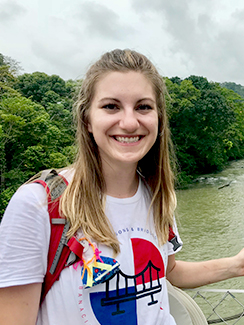
I didn’t fully understand what I was getting myself into when I signed up for this trip. The first day of work was extremely exhausting. Turns out it is very difficult to perform physical labor all day in the hot jungle. We experienced many adversities during our first week. The weather was not in our favor. In addition to the heat and humidity, we dealt with heavy rainstorms. However, we quickly learned to work in whatever conditions necessary to finish this bridge. From day two or three, we started to fall behind schedule. To try to get back on schedule, we took shorter meal breaks and worked later and later into the night. There were only two or three times we got home early enough to take showers without a headlamp.
Initially we faced many communication barriers with our host family and the community members. Over time I learned some Spanish words and phrases. I also became good at communicating via hand gestures and by saying “bueno” or “no bueno.” Working directly with the community is what really built our relationship. I worked an entire afternoon with a man whom I could barely communicate with. Despite our lack of conversation, the next day he introduced me to his family and thanked me for helping with the bridge. At the end of the trip I gave him my boots, and he thanked me in English.
It was very clear how much this community wanted the bridge. I thought our team worked hard, but we wouldn’t have finished without the help of the community members. I have never met so many hard-working and dedicated people in my life. There was no problem they couldn’t solve. They were inspiring. Many of them would show up barefoot and ready to work all day. They never let themselves be limited by what resources they had.
I really came to enjoy the time after work that the team spent hanging out together. For a couple hours we would forget how hard the day was and stop thinking about how hard the next day was going to be. And we formed great friendships. Despite being tired, wet, dirty, and sore, we would stay up late to get more time together. I wish I would’ve gotten more time with my team, and I hope I get to see them all again someday.
The inauguration of the bridge on the last day was amazing. This was our only day interacting with the entire community. Primarily male community members had helped build the bridge. At the inauguration we saw everyone. We got to hear multiple members of the community speak. Although I couldn’t understand them, it was clear how grateful and genuine they all were. I danced a lot, played with some of the children, and got to drink coconut water straight from the coconut. I didn’t want this day to end. I didn’t want to say goodbye to the community. The most rewarding moment was walking with the entire community across the bridge for the first time.
Overall, this journey was hard but extremely rewarding. Despite how physically exhausting this was, I enjoyed it completely. I would give anything to go back and do it all over again.
Rob
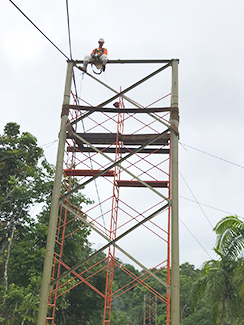
Eleven Parsons people showed up to a hotel in Panama City. We had all talked on the phone, but you never get a true impression of the team until everyone is finally physically present. We were all visibly excited and nervous, ready to start an adventure, but none of us truly understood how it would all play out.
We set out for Penanome, Panama, for supplies on our way to the bridge site. We were split into 4 different cars (plus a leader car with the B2P country reps). We managed to survive the drivers of Panama City and were off.
We successfully made it to our site, and all of us unpacked and prepared for the first night. I don’t think anyone slept well the first night due to heat and nerves, not to mention the roosters. We got an early start on Monday. It started slow, with everyone settling into their roles and for the first time truly understanding the magnitude of the project.
The next 11 days were a blur. The hours were long, the rain kept showing up, the heat was sweltering. We made it through 11 very long days. We took a picture every morning, and you can see the smiles fade and then slowly reappear. It was an exciting time installing the last bit of tie wire on the fencing by headlamp, determined to finish. The next morning, in the sunlight, we arrived at the bridge site, smiles on everyone’s faces, proud of the accomplishment.
We came in as 11 co-workers and left as a family.
Steve
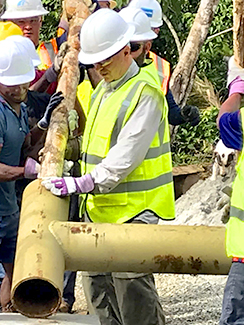
I was amazed at the resourcefulness of our team and all the community members who worked tirelessly for 12 straight days to build this bridge. There were many difficult tasks, including moving the heavy tower legs into position, first untangling then pulling the massive main cables across the river; dealing with mud everywhere, on everything, all-day-long; cutting and bending hundreds of rebars; moving, sorting, and cutting hundreds of heavy hardwood boards; recovering from rushing river torrents with whole trees and rafts of trees tangling our cables; and coping with the rainfall, humidity, heat, and exhaustion. It was a massive task, and to see it completed on time and without injury was a massive experience for myself, our entire team, B2P Panama, and the community.
We saw firsthand how much the local community needed this bridge and often how hard it was for them to cross the river, which they had to do to reach services, jobs, stores, and family. One day the river literally came up 5 to 6 feet in a matter of minutes due to heavy rainfall in the mountains, stranding dozens of locals and two of our team for many hours on the other side of the river. Our stranded team members took the opportunity to visit the Banacito village, more than an hour’s walk away, and stayed there overnight with a Peace Corps volunteer. Some local community members who were stranded braved the rushing waters and swam across the river in the dark! Having a safe footbridge that they can cross any time will be life-changing for all the people in the area.
I am grateful for the opportunity, proud of our team, thankful for Parsons’ support, and very, very happy to have met and worked with all the friendly and hardworking community members from Banacito. I will never forget the many experiences we had in those 2 weeks, the friendships made, and what was accomplished. I encourage all my colleagues at Parsons to volunteer for future opportunities, to volunteer in other ways in their communities and around the world, and to help Parsons make the world a better place.